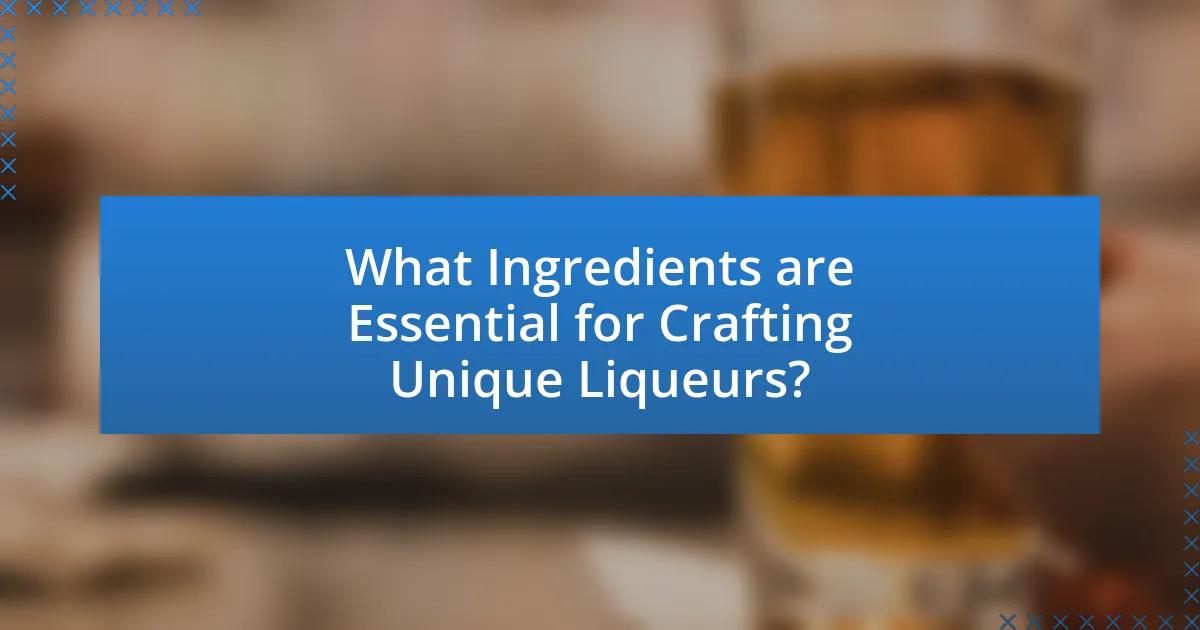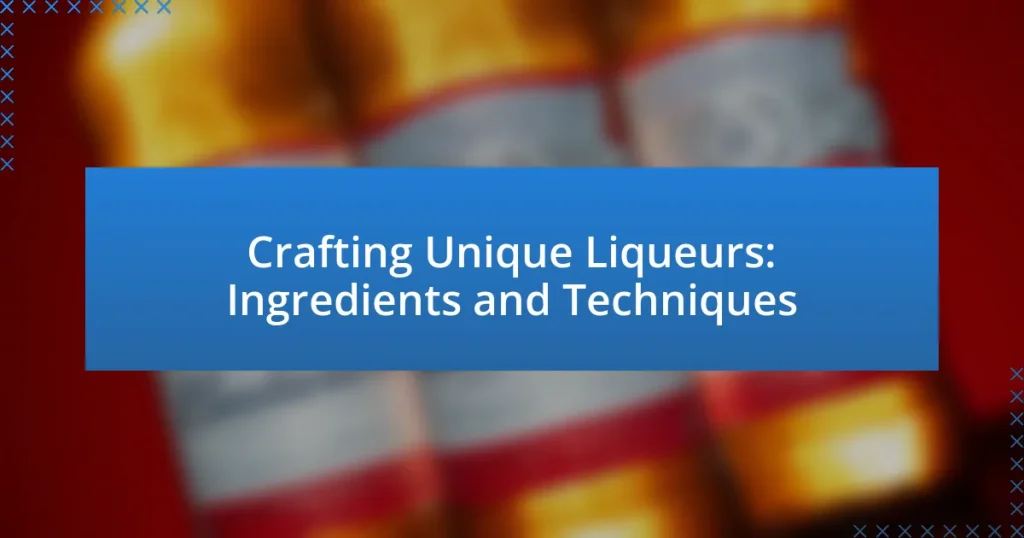Crafting unique liqueurs involves the meticulous selection of high-quality ingredients and traditional techniques to create distinct alcoholic beverages that are sweetened and flavored with fruits, herbs, spices, and botanicals. This article explores the definition and characteristics of unique liqueurs, the growing popularity of artisanal crafting, and the benefits of making liqueurs at home, including customization and cost-effectiveness. Key components such as base spirits, flavoring agents, and sweeteners are examined, along with essential techniques like maceration, infusion, and aging that contribute to the final product’s complexity and flavor profile. Additionally, best practices for bottling and storage are discussed to ensure the quality of homemade liqueurs.

What are Unique Liqueurs and Why Craft Them?
Unique liqueurs are distinct alcoholic beverages that are typically sweetened and flavored with various ingredients such as fruits, herbs, spices, and botanicals. Crafting unique liqueurs allows artisans to explore creativity and innovation in flavor profiles, catering to diverse palates and enhancing the drinking experience. The process often involves meticulous selection of high-quality ingredients and traditional techniques, which can result in products that reflect local culture and heritage. For example, the production of limoncello in Italy showcases the use of fresh lemons and traditional methods, emphasizing regional identity.
How are unique liqueurs defined in the world of spirits?
Unique liqueurs are defined in the world of spirits by their distinct flavor profiles, which result from the infusion of various ingredients such as fruits, herbs, spices, and botanicals into a base spirit, typically with added sugar. The process of crafting these liqueurs often involves meticulous techniques, including maceration, distillation, and aging, which contribute to their unique characteristics. For instance, the liqueur Amaretto is known for its almond flavor, while Chartreuse is recognized for its complex herbal blend, showcasing how specific ingredients and methods create signature tastes that differentiate one liqueur from another.
What distinguishes unique liqueurs from other alcoholic beverages?
Unique liqueurs are distinguished from other alcoholic beverages primarily by their infusion of flavors from fruits, herbs, spices, and other botanicals, often combined with a sweetening agent. This distinct characteristic sets them apart, as traditional spirits like vodka or whiskey typically do not incorporate such diverse flavoring processes. For example, liqueurs like Amaretto or Grand Marnier are crafted through meticulous methods that involve maceration or distillation of specific ingredients, resulting in a complex flavor profile that is not found in standard liquors. Additionally, the alcohol content of liqueurs is generally lower than that of spirits, often ranging between 15% to 30% ABV, which further differentiates them in terms of taste and usage in cocktails.
Why is the crafting of unique liqueurs gaining popularity?
The crafting of unique liqueurs is gaining popularity due to a growing consumer interest in artisanal and locally sourced products. This trend is driven by a desire for personalized flavors and experiences, as consumers increasingly seek out distinctive tastes that reflect local ingredients and cultural heritage. According to a report by Grand View Research, the global liqueur market is expected to grow significantly, with a rising demand for craft spirits contributing to this expansion. This shift towards unique liqueurs is also influenced by the rise of craft cocktail culture, where bartenders and enthusiasts prioritize quality and creativity in their drink selections.
What are the benefits of crafting your own liqueurs?
Crafting your own liqueurs offers several benefits, including customization, quality control, and cost-effectiveness. By creating liqueurs at home, individuals can tailor flavors to their preferences, using specific ingredients that suit their taste, which is not always possible with commercially available options. Additionally, crafting liqueurs allows for greater quality control, as makers can select high-quality ingredients and avoid artificial additives commonly found in store-bought products. Furthermore, making liqueurs at home can be more cost-effective in the long run, as bulk purchasing of ingredients can reduce overall expenses compared to buying premium liqueurs.
How does crafting liqueurs enhance personal creativity?
Crafting liqueurs enhances personal creativity by allowing individuals to experiment with diverse ingredients and flavor combinations. This process encourages innovation as makers can customize recipes, explore unique pairings, and develop signature flavors that reflect their personal tastes. The hands-on nature of crafting liqueurs fosters a sense of artistic expression, as individuals engage in the sensory experience of tasting, adjusting, and perfecting their creations. Additionally, the historical context of liqueur-making, which often involves traditional methods and regional ingredients, provides a rich backdrop for personal storytelling and creative exploration.
What cost advantages can come from making liqueurs at home?
Making liqueurs at home can significantly reduce costs compared to purchasing commercially produced options. The primary cost advantage stems from the ability to source ingredients in bulk, which often leads to lower prices per unit. For instance, buying fruits, herbs, and base spirits in larger quantities can decrease overall expenditure. Additionally, homemade liqueurs eliminate the markup associated with retail pricing, which can be as high as 50% or more. Furthermore, the customization of recipes allows for the use of seasonal or locally sourced ingredients, further minimizing costs. This approach not only enhances affordability but also provides the opportunity to create unique flavors tailored to personal preferences.

What Ingredients are Essential for Crafting Unique Liqueurs?
Essential ingredients for crafting unique liqueurs include base spirits, flavoring agents, sweeteners, and stabilizers. Base spirits, such as vodka, gin, or rum, provide the alcohol content and serve as the foundation for the liqueur. Flavoring agents, which can be fruits, herbs, spices, or nuts, impart distinctive tastes and aromas; for example, citrus peels are commonly used for their bright flavors. Sweeteners, like sugar or honey, balance the flavors and enhance the overall profile, while stabilizers, such as citric acid or preservatives, ensure the liqueur maintains its quality over time. These components are crucial in creating a well-rounded and unique liqueur.
What types of base spirits are commonly used in liqueur crafting?
Commonly used base spirits in liqueur crafting include vodka, gin, rum, whiskey, and brandy. These spirits serve as the foundation for liqueurs, providing distinct flavors and characteristics. For instance, vodka is often chosen for its neutral profile, allowing added flavors to shine, while gin contributes herbal and botanical notes. Rum, with its sweetness, is frequently used in tropical liqueurs, and whiskey adds depth and complexity. Brandy, made from distilled wine, offers fruity and rich undertones, making it a popular choice for dessert liqueurs.
How do different base spirits influence the flavor profile of liqueurs?
Different base spirits significantly influence the flavor profile of liqueurs by providing distinct characteristics that shape the overall taste. For instance, a liqueur made from vodka tends to have a neutral flavor, allowing added ingredients like fruits or herbs to dominate, while a liqueur based on rum often carries rich, sweet notes from the sugarcane, enhancing flavors like vanilla or caramel. Additionally, whiskey-based liqueurs can impart smoky or spicy undertones, which can complement flavors such as honey or nuts. The choice of base spirit not only affects the primary flavor but also the mouthfeel and sweetness level, as seen in the contrast between gin’s botanical notes and the creamy texture of a liqueur made from brandy.
What are the most popular base spirits for homemade liqueurs?
The most popular base spirits for homemade liqueurs are vodka, rum, gin, and whiskey. Vodka is favored for its neutral flavor, allowing the added ingredients to shine. Rum, particularly dark or spiced varieties, contributes rich sweetness and complexity. Gin, with its botanical notes, enhances liqueurs with herbal and floral characteristics. Whiskey adds depth and warmth, making it ideal for richer liqueurs. These spirits are commonly used due to their versatility and ability to blend well with various flavorings, making them staples in liqueur crafting.
Which flavoring agents can be used to create unique liqueurs?
Flavoring agents used to create unique liqueurs include fruits, herbs, spices, flowers, and nuts. Fruits such as cherries, oranges, and lemons provide natural sweetness and acidity, while herbs like basil, mint, and thyme add aromatic complexity. Spices such as cinnamon, cardamom, and vanilla contribute warmth and depth. Floral elements like lavender and elderflower introduce delicate notes, and nuts such as almonds and hazelnuts offer richness. These agents are often infused into a base spirit, allowing for a diverse range of flavors that can be tailored to specific recipes and preferences.
What fruits and herbs are ideal for flavoring liqueurs?
Fruits such as cherries, raspberries, and citrus (like lemons and oranges) are ideal for flavoring liqueurs, along with herbs like basil, mint, and rosemary. These ingredients provide a balance of sweetness and aromatic complexity, enhancing the overall flavor profile of the liqueur. For instance, cherries are commonly used in making cherry liqueurs, while citrus fruits contribute bright, zesty notes that are essential in many traditional recipes. Herbs like basil and mint add freshness and depth, making them popular choices in modern liqueur crafting.
How do spices and botanicals enhance liqueur recipes?
Spices and botanicals enhance liqueur recipes by adding complex flavors, aromas, and visual appeal. These ingredients contribute unique taste profiles that can transform a basic liqueur into a distinctive product, appealing to diverse palates. For instance, herbs like basil or mint can introduce freshness, while spices such as cinnamon or cardamom can impart warmth and depth. Historical practices in liqueur production, such as the use of botanicals in gin, demonstrate their effectiveness in creating signature flavors. The infusion of these elements not only elevates the sensory experience but also allows for creativity in crafting unique liqueurs that stand out in the market.
What sweetening agents are commonly used in liqueurs?
Common sweetening agents used in liqueurs include sugar, honey, and artificial sweeteners. Sugar is the most traditional sweetener, often used in the form of simple syrup or granulated sugar, providing a balanced sweetness that complements the flavors of the liqueur. Honey adds a distinct flavor profile and viscosity, enhancing the overall mouthfeel. Artificial sweeteners, such as aspartame or sucralose, are also utilized in low-calorie liqueurs to achieve sweetness without the added calories. These sweetening agents are essential in crafting liqueurs, as they help to balance the alcohol’s potency and enhance the overall flavor experience.
How do different sugars affect the taste and texture of liqueurs?
Different sugars significantly influence the taste and texture of liqueurs by altering sweetness levels, mouthfeel, and overall flavor profiles. For instance, sucrose, commonly known as table sugar, provides a clean sweetness that enhances the primary flavors of the liqueur without overshadowing them. In contrast, fructose, found in fruits, imparts a more complex sweetness and can create a thicker mouthfeel due to its hygroscopic nature, which attracts moisture. Additionally, using honey as a sugar source adds floral notes and a viscous texture, enriching the liqueur’s body and depth. The choice of sugar not only affects sweetness but also impacts the liqueur’s viscosity and how it interacts with other ingredients, ultimately shaping the drinking experience.
What alternatives to sugar can be used in liqueur crafting?
Alternatives to sugar in liqueur crafting include honey, agave syrup, maple syrup, and stevia. Honey provides natural sweetness and additional flavor complexity, while agave syrup is a low-glycemic option that dissolves easily. Maple syrup adds a distinct taste and can enhance the overall profile of the liqueur. Stevia, a zero-calorie sweetener, offers sweetness without the calories associated with sugar. These alternatives not only serve as sweetening agents but also contribute unique flavors and characteristics to the final product.

What Techniques are Involved in Crafting Unique Liqueurs?
Techniques involved in crafting unique liqueurs include maceration, distillation, infusion, and aging. Maceration involves soaking fruits, herbs, or spices in alcohol to extract flavors, while distillation purifies and concentrates these flavors through heating. Infusion is the process of steeping ingredients in alcohol to create distinct flavor profiles, and aging allows the liqueur to develop complexity and depth over time, often in wooden barrels. These methods are foundational in the production of liqueurs, enabling the creation of diverse and innovative flavor combinations.
How do the infusion and maceration processes work?
Infusion and maceration are processes used to extract flavors from ingredients into a liquid, typically alcohol. In infusion, the ingredients, such as herbs or fruits, are steeped in a liquid, allowing their flavors to dissolve and blend over time, usually at room temperature or with gentle heat. This method is commonly used for creating flavored spirits and liqueurs, where the infusion time can vary from hours to weeks, depending on the desired intensity of flavor.
Maceration, on the other hand, involves soaking the ingredients in a liquid to soften them and release their flavors, often using a more aggressive approach, such as crushing or chopping the ingredients before soaking. This process is particularly effective for extracting essential oils and compounds from botanicals, resulting in a more robust flavor profile. Maceration typically occurs over a shorter period compared to infusion, ranging from a few days to a couple of weeks.
Both processes rely on the principle of solubility, where the flavor compounds in the ingredients dissolve into the liquid, creating a harmonious blend that characterizes the final product.
What steps are involved in the infusion process for liqueurs?
The infusion process for liqueurs involves several key steps: selecting ingredients, preparing the base, combining the ingredients, steeping, and filtering. First, the selection of ingredients, such as fruits, herbs, or spices, is crucial as they determine the flavor profile of the liqueur. Next, the base, typically a neutral spirit like vodka or grain alcohol, is prepared to ensure it effectively extracts flavors. The selected ingredients are then combined with the base in a suitable container. The mixture is steeped for a specific duration, which can range from a few days to several weeks, allowing the flavors to meld. Finally, the infusion is filtered to remove solid particles, resulting in a clear liqueur ready for bottling. This method is widely used in liqueur production, as evidenced by traditional recipes and practices in various cultures.
How does maceration differ from infusion in liqueur crafting?
Maceration involves soaking solid ingredients, such as fruits or herbs, in alcohol to extract flavors, while infusion typically refers to the process of steeping these ingredients in a liquid, often at a lower temperature, to achieve a similar flavor extraction. In maceration, the solid ingredients are usually left in the alcohol for an extended period, allowing for a more intense flavor profile, whereas infusion may occur over a shorter duration and can involve heat to accelerate the extraction process. This distinction is crucial in liqueur crafting, as the choice between maceration and infusion can significantly impact the final taste and aroma of the liqueur.
What role does aging play in the development of liqueurs?
Aging plays a crucial role in the development of liqueurs by enhancing their flavor complexity and smoothness. During the aging process, liqueurs interact with the wood of barrels or other aging vessels, which imparts additional flavors such as vanilla, caramel, and spice. This interaction also allows for the evaporation of volatile compounds, leading to a more refined and balanced taste profile. Studies have shown that aging can significantly alter the chemical composition of liqueurs, resulting in a smoother mouthfeel and a more harmonious blend of flavors, which is essential for high-quality liqueurs.
How does aging affect the flavor and aroma of liqueurs?
Aging significantly enhances the flavor and aroma of liqueurs by allowing chemical reactions to occur that develop complexity and depth. During the aging process, compounds such as esters, phenols, and aldehydes interact, leading to a smoother and more rounded taste profile. For example, the interaction between the liqueur and the wood of the aging barrel can impart additional flavors like vanilla, caramel, and spice, which are not present in younger liqueurs. Studies have shown that liqueurs aged in oak barrels can exhibit a marked increase in aromatic compounds, contributing to a richer sensory experience.
What are the best practices for aging homemade liqueurs?
The best practices for aging homemade liqueurs include using glass containers, maintaining a cool and dark storage environment, and regularly tasting the liqueur to monitor its development. Glass containers prevent chemical reactions that can occur with metal or plastic, ensuring the purity of flavors. A cool, dark environment slows down oxidation and preserves the liqueur’s integrity, as light and heat can degrade the quality. Regular tasting allows for adjustments to be made, ensuring the final product meets desired flavor profiles. These practices are supported by the understanding that aging enhances complexity and depth in liqueurs, as evidenced by traditional methods used in the production of well-known spirits.
What are the common bottling and storage techniques for liqueurs?
Common bottling techniques for liqueurs include using glass bottles with airtight seals to prevent oxidation and maintain flavor integrity. Additionally, liqueurs are often bottled at specific alcohol content levels, typically between 15% and 30%, which helps preserve their quality. Storage techniques involve keeping liqueurs in a cool, dark place to avoid light exposure and temperature fluctuations, which can degrade the product over time. Properly stored liqueurs can last for several years, as their high sugar and alcohol content act as preservatives.
How should liqueurs be bottled to maintain quality?
Liqueurs should be bottled in dark glass containers to protect them from light exposure, which can degrade flavor and color. Additionally, using airtight seals prevents oxidation, preserving the liqueur’s quality over time. Research indicates that light and air are significant factors in the deterioration of liqueurs, with studies showing that exposure to UV light can lead to a loss of aromatic compounds and color intensity. Therefore, proper bottling techniques, including the use of dark glass and secure closures, are essential for maintaining the integrity of liqueurs.
What storage conditions are optimal for homemade liqueurs?
Homemade liqueurs should be stored in a cool, dark place, ideally at a temperature between 15°C to 20°C (59°F to 68°F). This temperature range helps maintain the flavor and quality of the liqueur over time. Additionally, liqueurs should be kept in tightly sealed bottles to prevent oxidation and contamination, which can alter their taste. Exposure to light and heat can degrade the ingredients, so dark glass bottles are preferable. Studies indicate that proper storage conditions can significantly extend the shelf life of homemade liqueurs, preserving their intended flavors and aromas.
What are some tips for successfully crafting unique liqueurs?
To successfully craft unique liqueurs, focus on selecting high-quality ingredients and experimenting with diverse flavor combinations. Using fresh fruits, herbs, and spices enhances the liqueur’s complexity and depth. For instance, infusing spirits with seasonal ingredients can yield distinctive flavors that reflect the time of year. Additionally, precise measurements and controlled steeping times are crucial; for example, a longer infusion can intensify flavors, while shorter times may yield a more subtle profile. Balancing sweetness and acidity is also essential; using natural sweeteners like honey or agave can create a more nuanced taste. These practices are supported by the fact that artisanal liqueurs often emphasize ingredient quality and innovative techniques, leading to unique and memorable products.
How can beginners avoid common mistakes in liqueur crafting?
Beginners can avoid common mistakes in liqueur crafting by meticulously following recipes and measuring ingredients accurately. Accurate measurements ensure the balance of flavors, which is crucial for a successful liqueur. Additionally, beginners should use high-quality base spirits and fresh ingredients, as these significantly impact the final product’s taste and aroma. Research indicates that using fresh botanicals can enhance flavor profiles, making the liqueur more appealing. Furthermore, allowing sufficient infusion time is essential; rushing this process can lead to unbalanced flavors. By adhering to these practices, beginners can create well-crafted liqueurs that meet their expectations.
What resources are available for further learning about liqueur crafting?
Books, online courses, and workshops are valuable resources for further learning about liqueur crafting. Notable books include “The Art of Liqueurs” by Andrew Schloss, which provides detailed recipes and techniques, and “Craft Liqueurs at Home” by Ellen Zachos, offering insights into ingredient selection and flavor combinations. Online platforms like MasterClass and Udemy offer courses specifically focused on liqueur making, taught by industry experts. Additionally, local distilleries often host workshops that provide hands-on experience in crafting liqueurs, allowing participants to learn directly from professionals in the field.


